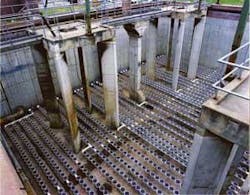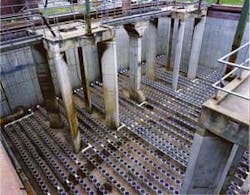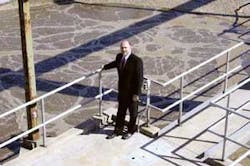by John Mitchell
While changes in discharge regulations, demand or ability to meet upgraded water quality standards can singly require urgent improvements to a wastewater treatment facility, in the case of Wastewater Treatment Plant No. 20 in Kansas City, KS, all three converged. The change agents: the state of Kansas revising its surface water quality standards, the development of a NASCAR/IndyCar racetrack surrounded by new retailers and residential areas in Wyandotte County, KS, and the deterioration of a nearly 30-year-old wastewater treatment plant. The challenges mounted with an aim of increased energy efficiency, making this project one of the most complicated — and later successful with 1.7 million kilowatt-hours saved the year following the plant’s completion — wastewater treatment plant upgrades in the region.
More Restrictive Water Quality Standards
Just prior to the onset of a 1998 study conducted on Wastewater Treatment Plant No. 20, the state of Kansas revised several surface water quality standards that affect the Kansas River, where the plant discharges. Included were revised ammonia nitrogen and fecal coliform limits. Wastewater Treatment Plant No. 20’s original permit required only monitoring ammonia nitrogen and fecal coliform, while the revised permit imposes numeric limits for both. Initially, 19 mg/l of ammonia nitrogen in the winter and 15.5 mg/l in the summer was included in the national pollutant discharge elimination system permit with the expectation that permit limits would be revised downward over subsequent permit renewals. A revised fecal coliform limit of 200 colonies per 100 ml of effluent was also imposed.
Change in Demand
With the Kansas Speedway opening in June 2001, Wastewater Treatment Plant No. 20 needed significant modifications in order to handle flows that would increase from 4.17 mgd to 9.21 mgd during a peak race day event, the result of the tens of thousands of temporary users on race days. Because of the physical nature of the sparged air system, there wouldn’t be enough oxygen to support the nitrobacter and nitrosomonas bacteria that reduce ammonia nitrogen. This seasonal and instantaneous fluctuation in demand coupled with the new retail and residential developments in the surrounding Wyandotte County area required a unique aeration solution for this wastewater treatment plant.
Deterioration with Age
Until this endeavor no major updates had occurred since the wastewater treatment plant’s 1978 construction. To be frank, the old 900-hp aeration system was obsolete the day it was installed. In addition, the main switchboard, which distributes power to the entire plant and serves as the motor control center for the solids handling and influent pump stations, had suffered critical deterioration from the attack of hydrogen sulfide. All processes needed to be modernized in some fashion.
Challenges
In addition to tightened regulations, the occasional doubling of influent flows and antiquated equipment, upgrading Wastewater Treatment Plant No. 20 posed additional obstacles.
As usual with wastewater treatment plants, the facility needed to continue operations throughout the construction process, so Burns & McDonnell engineered the new systems to be implemented in a tightly controlled, sequential manner. The first step became separating the power feeds at the switchboard into two components so that one could be active while the other was de-energized for replacement. Further construction occurred in rigid sequences to allow continuous operation of the facility. This required exceptional planning, communication and cooperation between the engineering, operations and construction functions throughout the 14-month construction period. Space for both old and new equipment was another hurdle, as all updates needed to occur within the existing space.
Process Improvements
To accommodate the increased demand, all unit processes were improved to accommodate an average daily flow of 9.2 mgd and peak wet weather flow rate of 21 mgd. The old, energy-draining sparged air system consisted of eight 75-hp turbine mixers and one 150-hp multi-stage blower, which consumed up to 900 hp a day regardless of influent flows and oxygen demand. The new combined single- and multi-stage blowers, fine-bubble aeration and dissolved-oxygen control system now require only 300 hp to accommodate the increased demand.
Part of the new aeration system, the single-stage blower — efficient at full capacity down to 50 percent — handles the base load for the majority of the year and typically does not reach levels below 80 percent capacity while it functions as the lead blower. Sitting latent until it’s time to gear up for race days, a multi-stage blower takes over the base load, while the single-stage handles the remaining demand. This maximizes power savings, as the multi-stage blower has limited efficiency at reduced capacity. During a peak demand event, such as a Kansas Speedway race, the now-automated controls monitor and transfer between the single- and multi-stage blowers as needed. An additional multi-stage blower is present as backup to meet the redundancy requirement.
Disinfection is accomplished through the use of ultraviolet radiation. A conventional low-pressure, low-output system was selected. The selection process included evaluation of both capital and operating cost as well as careful consideration of manufacturers’ local support capabilities. Although the low-output system requires a significantly larger number of lamps, the efficiency of the lamps proved to be superior to competing systems and resulted in lower energy costs over the life expectancy of the installation. The system’s output and, hence, power consumption is automatically varied to match effluent flow rates, thus maximizing system efficiency. The system was initially constructed to treat up to 10 mgd with infrastructure in place to upgrade to 21 mgd by installing additional lamp modules. An innovative level control system allows maintenance of water levels in the UV reactor regardless of backwater effects from the Kansas River. This approach allowed for elimination of an effluent pumping station that would have otherwise been required for the plant when the river is at the 100-year flood stage.
Process controls at Wastewater Treatment Plant No. 20 are now almost completely automated, reducing the number of full-time staff required to operate the facility, thus, yielding cost savings for the Unified Government of Wyandotte County/Kansas City, KS. The supervisory control and data acquisition (SCADA) monitoring system provides real time monitoring and control capabilities for each unit process.
SCADA information is transmitted from Wastewater Treatment Plant No. 20 to the Kaw Point Treatment Plant, which is staffed 24 hours per day, over a secure spread spectrum radio system. The system was designed with the capability to expand communication to more than 50 other pumping stations in the unified government’s collection system. Ultimately, this backbone of the radio communication system will allow phasing out the telephone communication system which can become overloaded during heavy rain events when all remote pump stations transmit operating status simultaneously.
Energy-Efficient and Payback Optimization
The most impressive effect of the reconfiguration and modernization of the plant is its staggering 300 percent energy savings, in spite of handling an increased capacity. In 2002 the Wyandotte County/Kansas City, Kan., Water Pollution Control Division’s energy usage totaled about 19.6 million kilowatt-hours for its three treatment plants and 52 pump stations, a significant drop from its 1999 total of around 21.3 million kilowatt-hours. The decrease can solely be attributed to the improvements at Wastewater Treatment Plant No. 20 — an energy savings so dramatic that the municipality’s officials thought half the plant must have been shut down to reach that figure.
Improvements at Wastewater Treatment Plant No. 20 reached payback within the five-year projection despite lower-than-projected flows from the Kansas Speedway and lower than projected increases in utility power cost. The lower-than-projected flows from the Kansas Speedway fares well for the plant due to the continued development in the Wyandotte County area.
About the Author: John Mitchell, PE, director of wastewater practice at Burns & McDonnell, actively oversees planning, design, construction and startup of numerous wastewater treatment facilities, ranging in both size and complexity. His expertise includes design-build project delivery, process design, wastewater collection and planning, wastewater treatment, hydraulic modeling, solids handling and processing, pump station design and combined sewer overflow abatement.





